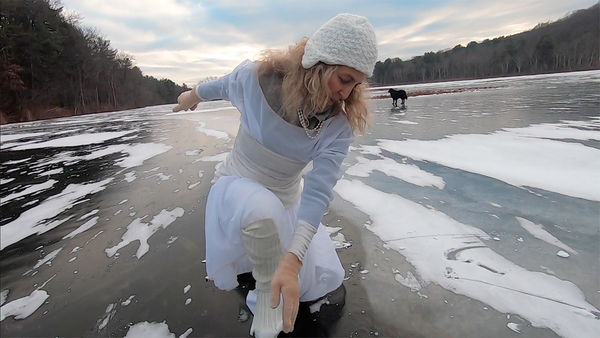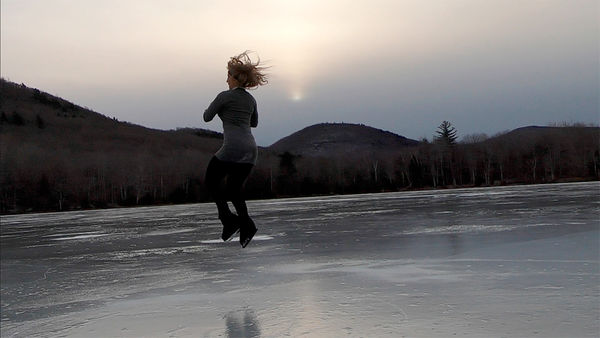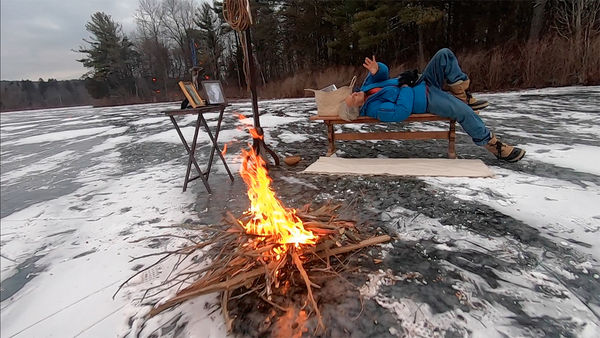Woronoff combines movement and artistry on ice

Beth Woronoff performs in “Kuma Brings the Pearls,” a short film that debuted at the Lake Placid Film Festival. Photo provided
LAKE PLACID – Veteran figure skater and movement innovator Beth Woronoff thrives on performing, and her shows always leave an impact. Her most recent performance, as the lead in a short film, “Kuma Brings the Pearls,” which debuted at the Lake Placid Film Festival this year, once again showcased her exceptional skating and artistic talents.
“Our interest was in the movement; we have an hour and 25-minute version that we are still working on in which the movement is more primary,” she said in describing what makes the film unique. “We went with a short film as this was our first time and it seemed like more people would be able to relate to it.”
Born in Hawaii, Woronoff still found a way to pursue expressing herself from an early age.
“I had already shown a flair for performing while toddling around the malls,” she explained. “When I was 3, our family moved back to Brooklyn where my grandparents lived, and my mother inaugurated me into the glamorous side of ice skating by taking me for my first skate at Rockefeller Center.”
Her family moved to NYC when she was 11 years old, giving her the opportunity to pursue skating seriously. At age 15, Woronoff started working with coach Adam Leib for the next five years at Sky Rink, and trained five hours each day before going to high school, then while attending college at NYU.

Beth Woronoff performs in “Kuma Brings the Pearls,” a short film that debuted at the Lake Placid Film Festival. Photo provided
“As happens to many skaters, my passion for skating may have ended when I passed all my free skate tests and finished competing in Senior Ladies,” she said. “However, this was New York City and The Ice Theatre of New York had been established.”
Founded in 1984 by Moira North, the legendary Ice Theatre of New York enabled skaters, dancers and artists to work in concert to produce artistic masterpieces that, according to their website, “integrate the sensibilities of contemporary dance, music and art, challenging the perceptions and conventional definitions of figure skating.”
The Theatre attracted the artists of the sport, such as 1976 Olympic and World Champion John Curry, 1983 and 1984 Canadian silver medalist Gary Beacom, and finally gave skaters the permission to stretch the boundaries of what skating could be. For a skater like Woronoff, the ITNY showed what could be possible in skating.
“John Curry taught classes which I was able to take for three summers. JoJo Starbuck and multiple other famous skaters trained at Sky Rink, and Gary Beacom frequently performed with ITNY,” Woronoff said.
Her enthusiasm and talent caught the eye of ITNY leaders, and she was asked to be ITNY’s first apprentice at 19 years old, and became a full company member within a few months, touring with the esteemed group. The Theatre helped Woronoff grow as an artist and gain a further appreciation of how to present the medium differently.

A scene from “Kuma Brings the Pearls,” a short film that debuted at the Lake Placid Film Festival. Photo provided
“Moira (North), the director of ITNY, brought in contemporary dance teachers and choreographers to work with the company; she gave me tickets to see dance performances at the Joyce Theater and introduced me to the Martha Graham Company,” she said.
This greater exposure to modern dance would influence her skating, and guide her contributions as an artist.
“I fell in love with Graham’s work and studied at her studio for five summers,” Woronoff said. “It became my passion and privilege to be part of the wave of skaters working to bring to skating a new form of movement just as Graham had done for the dance world.”
Woronoff skated with the ITNY for nine years and in many roles, until 1997. The company also performed three of her ensemble works. Like her hero Graham, Woronoff celebrated and demonstrated a new type of movement by creating a company called Calle Ouvert Ice, whose performances will debut this spring throughout the Northeast.
One of her ensemble pieces, called “Red,” will be revived and skated as a solo by 1992 Olympian Karen Courtland Kelly, who lives and coaches in Lake Placid; Courtland Kelly and Woronoff rehearsed the piece in the 1932 arena this summer.
The tour seeks to provide a place for female skaters over age 40 to express themselves creatively while inspiring others to greater freedom of movement, no matter what the age.
“The company will feature a cast of seven female skaters all over the age of 40, most in their 50s skating emotionally charged original movement,” Woronoff said. “Our tour will include a performance at the Skating Club of Boston, and in Maine, New Hampshire, New Jersey and Connecticut, and we have been in discussion and working with Karen Courtland Kelly, Kitty Kelly, Elin Schran, Kathy Cutone, and Colette Brabant”
Woronoff’s partner in life and creative endeavors is David Brown, who was a principal dancer with the Martha Graham Company and also had his own company for 20 years, Monte/Brown Dance, also known as Elisa Monte Dance. They met in 1997, while Woronoff was skating with ITNY.
As part of her exploration of other forms of skating expression, Woronoff re-discovered figures fairly recently as well. Several years ago, she was unable to skate or even walk much for three years due to injury, and a discussion with Brown led her to start practicing figures again.
“David asked me, ‘what is the ballet bar of skating?'” Woronoff said. “One evening I told him about figures, he was overjoyed to hear about them and immediately made the connection. ‘You know how to do these?’ he asked. ‘Yes,’ I said proudly, and went on to explain how edges and turns work.
“I found out about the World Figure & Fancy Skating Competition one month before last year’s (competition) and that’s when I really started to train my figures.”
Figures, the discipline of tracing patterns on an ice surface, was considered a “lost art” by much of the skating community until 2015, when the World Figure Championships debuted in Lake Placid, organized by World Figure Sport organization founder Karen Courtland Kelly. Like Courtland Kelly, who believed in the value and continued relevance of figures to today’s skaters, Woronoff enjoys practicing the figures.
“I find that I can concentrate and lose myself in them for hours; I love having the opportunity to make each edge purer and my glides smoother, all of the twisting is wonderful for one’s body,” Woronoff said. “I have gained back so much of my skating and continue to improve because of figures. They are perfect for adults and I hope more adults find out about this lost art.”
In preparation for the World Figure & Fancy Skating Championships this year (the fancy skating component, in which style and purity of skating is the focus, was added after the first World Figure Championships), Woronoff wowed the audience at the Lake Placid Adult Skating Week exhibition in August with “Beethoven to his Moonlight Sonata,” an elegant piece choreographed by Brown that she would perform in the Fancy Skating event.
Woronoff and her husband live in Hudson, New York, and her tour company will have a residency and begin its tour in Arlington, Virginia; she and Brown commute from Arlington to Montreal to work with their skaters. They also spend some of their time in Merida, Mexico, where they have access to a rink 30 minutes from the beach, and they plan to offer adult skating retreats there. To Woronoff, the most important part of her work is to create meaning for those watching.
“My personal goal is to create a language of exercises and movements that have emotional impact, that stay with the viewer after they have left, rich with metaphors,” she said. “I often look at dance by Martha Graham, Pina Bausch and Alvin Ailey for inspiration before I skate, trying to figure out how to do what they have done on the floor.”
All of these experiences and pursuits brought Woronoff to film-making. Her first film, “Kuma Brings the Pearls,” is described thus: “The Jamaican enlists the help of the dog, Kuma, to win over the Skater.”
The film stars Woronoff’s husband and co-director of the film, David Brown, as the Jamaican, while Woronoff plays the skater, of course. It came about as a result of their visit to a frozen lake last winter to work on ideas for their choreography.
“When we got home and looked at the footage we were amazed, it was stunning scenery and the movement was interesting,” she said. “We decided to make a trilogy – three lakes, three gifts, three shoots – and were lucky to have found three perfect weather and ice days.”
“Unlike many films, we did everything ourselves, passing a GoPro back and forth between us, shooting film of each other and our dog. We had conversations about the storyline but no script was written.”
Rather than focusing on a storyline as the primary driver of the action, the story is told largely through movement, with relatively little dialogue. What dialogue there is, is in English and Jamaican Patois, the latter of which was spoken by Brown’s character. Brown was born in Jamaica and lived there until he was 15 years old. Subtitles help the audience follow the story.
The entire film was shot within three weeks. Scenes were shot within a few hours each time, with three shoots done in total.
“It was too cold to stay out on the ice much longer (than a few hours at a time),” Woronoff said. “I improvised movement and David gave me verbal cues, sometimes showing me a movement, and all the while he was recording with the GoPro.”
Woronoff plans to continue film-making, showcasing a unique international film movement at the same time.
“We will get back on the lake to shoot this winter, perhaps in Lake Placid,” she said. “We are very interested in the ‘Slow TV’ movement that began in Norway with a film of a train trip that lasted 12 hours.
“We want to film continuously with very few cuts so that we create a long expanse of movement and time allowing the viewer to slow down and rest in the beauty of the scenery and movement.”
Lake Placid remains an important part of Woronoff’s skating life, and she hopes to spend more time there, perhaps performing and filming here again soon.
“We (the tour) hope to perform in Lake Placid as well,” she said. “This winter we will go back out on the lake and film as we did last winter. We have a few ideas that are developing, hopefully, conditions will be good for our creativity and for the ice.”
- Beth Woronoff performs in “Kuma Brings the Pearls,” a short film that debuted at the Lake Placid Film Festival. Photo provided
- A scene from “Kuma Brings the Pearls,” a short film that debuted at the Lake Placid Film Festival. Photo provided





